Beloved Beasts: Fighting for Life in An Age of Extinction
Air Date: Week of April 30, 2021
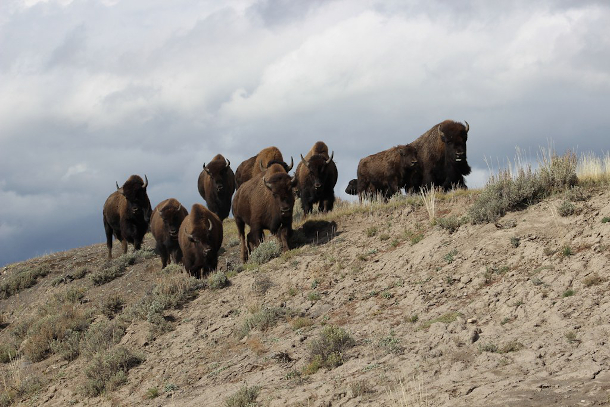
As many as 30-60 million American Bison once roamed the plains. They were nearly hunted to extinction around the turn of the century but have recovered from the brink thanks to conservation efforts. (Photo: Road Travel America, Flickr CC BY 2.0)
BELOVED BEASTS: FIGHTING FOR LIFE IN AN AGE OF EXTINCTION: Animals like the American Bison, bald eagle, and giant panda are just a few of the charismatic species that have come dangerously close to extinction. But thanks to some visionaries, species like these have been saved from that fate. In her new book Beloved Beasts: Fighting for Life in an Age of Extinction, science writer Michelle Nijhuis shares the stories of some conservation heroes. She joins Host Jenni Doering to talk about Rosalie Edge and Aldo Leopold and to debunk the myth of the tragedy of the commons.
Transcript
DOERING: And I’m Jenni Doering.
American Bison… Bald Eagle… Giant Panda. These are just a few of the charismatic species that have come dangerously close to extinction. Once a species is gone it’s gone forever, and these days humans are usually to blame. But thanks to some visionaries, large herds of bison are back, bald eagle populations are soaring, and giant panda numbers are on the rise. The stories of some conservation heroes are told in a new book by science writer Michelle Nijhuis. It’s called Beloved Beasts: Fighting for Life in an Age of Extinction, and Michelle Nijhuis joins me from White Salmon, Washington. Welcome back to Living on Earth!
NIJHUIS: Hi, Jenny, thanks so much for having me.
DOERING: You know, one of the stories in your book, Michelle, that really inspired me was about Rosalie Edge, and her courage in standing up against these Audubon Society leaders the establishment that was really unwilling to protect birds that sportsmen considered pests or targets. She even bought a mountain to help conserve raptors. Can you tell us about her and her story?
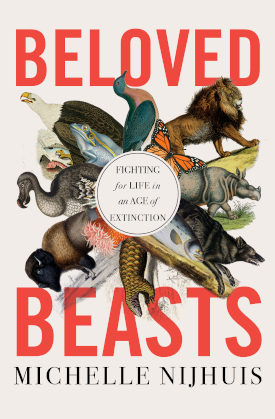
The cover of Beloved Beasts: Fighting for Life in an Age of Extinction (Image: courtesy of W.W. Norton)
NIJHUIS: Rosalie Edge is one of my favorite characters too. Rosalie Edge, immersed herself in the suffrage movement. She was a leading suffragist fighting for women's right to vote. And after that victory was achieved after suffrage was achieved in New York State and after it was on its way to being achieved nationally. Rosalie edge and her husband separated and while she was mourning the breakup of her marriage, she discovered real solace in the company of birds. And she wrote very movingly about how the natural world was a comfort to her in the midst of this personal disaster. And so she became in her 40s a devoted birdwatcher. And as she got to know the birding community in New York City, she learned that the primary organization fighting for the protection of birds the Audubon Society was not sticking up for all birds. The Audubon Society was sticking up for the birds that it considered, quote, unquote, good birds, not birds of prey that many of its members considered pests at the time. So Rosalie edge thought this was ridiculous, and she took it upon herself to show up at a annual meeting of the board of the Audubon Society and give them a piece of her mind. And she rallied Audubon members and other people who cared about conservation to demand that the Audubon Society which had become a bit complacent. They demanded that the Audubon Society get more ambitious on behalf of other species and work for the protection not just of species that they happen to like and appreciate but all species.
DOERING: Yes and they wrote some pretty fiery pamphlets that just got sent out, I guess, mailed out by the hundreds calling for this establishment to take a stand.
NIJHUIS: Well, they were very popular, they named names and, you know, warned of what tragedies would befall the natural world if the Audubon Society didn't grow some kind of backbone. And she made herself a real pain in the neck. And she succeeded. she succeeded at waking up the Audubon society's leadership and membership. And I think that the Audubon Society retains a sort of grassroots feistiness that owes a lot to Rosalie Edge.
DOERING: And some of these birds that weren't being protected properly. Were raptors like hawks especially. Why were these Raptors under such attack?
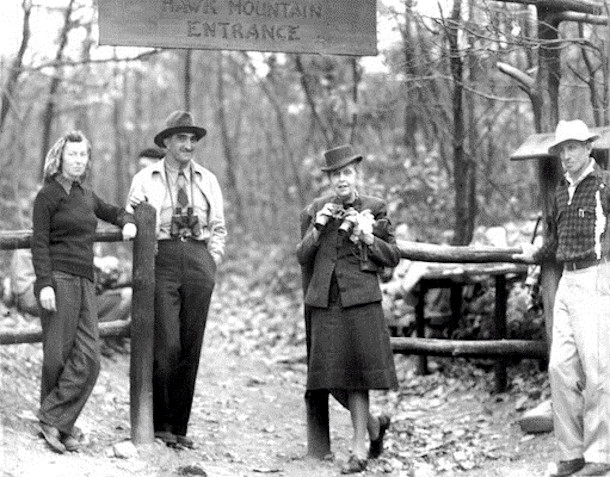
Conservationist Rosalie Edge and companions at the entrance of Hawk Sanctuary, 1940. (Photo: courtesy of Hawk Mountain Sanctuary)
NIJHUIS: Well, a lot of sportsmen did consider raptors pests. They had these exaggerated ideas about how often they ate farm animals and poultry mostly, and they just disapproved of them in a way they thought they were scavengers and kind of lowly animals. So there was a particular Ridgeline in Pennsylvania where the topography and the wind currents converge so that the hawks that were migrating up and down the East Coast in the spring and fall, were funneled over this one ridge top, so sportsmen would go there. And because there were so many raptors passing so close to the top of this ridge top, they were able to just shoot them by the dozens, even the hundreds. And Rosalie edge saw a picture of hot carcasses lined up on the forest floor and was just horrified that this was happening that this, you know, these birds were just being shot wholesale, really for no reason. And she found out that the land on that ridge top was for sale, and she bought it and established a hawk sanctuary that still stands today. And not only has it protected the Raptors that use that migration corridor. But the data taken there, Rosalie Edge, suggested that the caretakers start recording the numbers and kinds of birds that passed over during their migration. That data is now one of the longest record of raptor migration in the world.
DOERING: Wow, it sounds amazing to be there. And you did go there. What is it like to be on Hawk Mountain watching the raptors flyby?
NIJHUIS: I really recommend that people take a trip. It's not too far from most of the major East Coast cities but it is a different world because you climb up to the top of this ridge line, kind of an unassuming looking ridge line in Pennsylvania. But once you get up there, you realize how magical it is because the birds are flying by, not only above you, but sometimes beneath you. So it's not not only an amazing experience of being close to birds, but it's a popular place. And so most of the time you're up there with, it can be just a couple of other people or it could be a whole crowd of people who are all just gripped by this natural phenomenon. And it's delightful to feel their joy along with your own as you stand there and watch these birds do what they have done for so many years, and can do thanks to the foresight of Rosalie edge.

The view from the top of Hawk Mountain in Eastern Pennsylvania. (Photo: Mike Nichols, Flickr, CC BY ND NC 2.0)
DOERING: So another person who really helped shape conservation, and maybe a lot of people will know this name was Aldo Leopold, what do you think is his most important message for us today?
NIJHUIS: Well, many people may have run into Aldo Leopold's book, A Sand County Almanac. It's his best known book. I've always loved Aldo Leopold. And it was a real joy to get to know him better. In the process of writing this book, he was such an eloquent writer. And he had such a sense not only of the complexity of other species, but of the complexity of the human species. But his primary accomplishment, I think, was to bring the science of ecology into conversation with the work of conservation, because one thing I observed in learning about the history of conservation is that some people are drawn to conservation because they are eager to get away from their fellow humans, sometimes for very good reasons. Sometimes people, you know, had had a terrible loss early in life, and they found comfort in other species, or as I mentioned, like Rosalie Ed's, they experienced a tragedy, and they found solace and other species. But there are definitely people in conservation who feel more comfortable with other species than with their own. And Aldo Leopold was not one of those people, he he felt as warmly toward his own species as he did toward other species, I can't help but think that that informed his work. And that he saw, unlike so many conservationists, he saw that humans could have a constructive role to play when it came to conserving other species, that conservation wasn't just about protecting species from the destruction that humanity can wreak. It was also about finding that constructive role. And I think that's still a piece that's missing from conservation today. And that's something that Leopold can still remind us of.
DOERING: Yeah, that really resonates with the part of your book, where you're talking about the myth of the tragedy of the commons. And you know, the fact that it's handed us this idea that the only way to manage resources sustainably, whether that's like an aquifer or an antelope herd, is to impose this order from the top down. How has this been proven to be the wrong way of looking at conservation?

Aldo Leopold is considered by many to be a groundbreaking writer about wildlife ecology. (Photo: Pacific Southwest Forest Service, Wikimedia Commons CC BY 2.0)
NIJHUIS: The tragedy of the commons is a mysteriously persistent metaphor that was proposed in the late 1960s, by an ecologist named Garrett Hardin. And as you say, he theorized this was an idea he had not something he tested in real life. But he he proposed that humans given the chance would use up as many resources as they could until the resource was gone. And that the only way around it was total government control or total privatization. But scientists since then, and even while he was proposing this theory, were observing that that was not true at all, that people had for centuries, developed rules that allowed them to both sustain their own livelihoods and sustain the resources, the species that they needed. And I think the tragedy of the commons is persistent, in part because it does happen. And we do experience it in small ways all the time. Anyone who's been in a traffic jam has experienced the tragedy of the commons.
DOERING: Or trying to buy that last roll of toilet paper.
NIJHUIS: Yes, or trying to buy that last roll of toilet paper. I mean, it's it is all around us in small ways. But I think it's so important for everyone and for the conservation movement, in particular, to remember that it doesn't have to be that way that we as humans have figured out ways of avoiding it. And even as Garrett harden was publishing, the theory of the tragedy of the commons, in the journal Science, there was a young political scientist named Elinor Ostrom, who was reading his article and thinking, well, that's not true at all, because she was working on her PhD in Los Angeles at the time, and she had been observing that water users in the Los Angeles basin where groundwater is of course, you know, a highly prized resource, had figured out a way of cooperatively sharing their resource that didn't involve radical privatization that didn't involve total government control and and she devoted the rest of her life to studying systems all over the world where people were cooperatively managing their resources. And she eventually won the Nobel Prize in Economics for her work shortly before her death. So she's very respected and she, in fact, was the founder of a whole field that continues today. But I think that as respected as she was in his her work is still not as well known as it should be. I think it It hasn't had the staying power that the idea of the Tragedy of the Commons has, but I do hope that we as a society, we as a species, will embrace the complexity of Elinor Ostrom work because in that complexity, I think lies the solutions that we need for conservation to be meaningful worldwide.
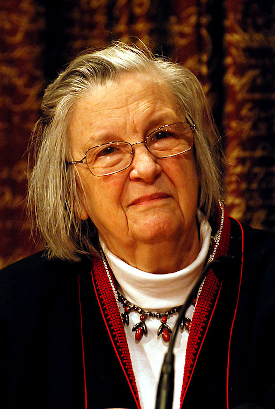
Elinor Ostrom’s research presented an alternative to the “tragedy of the commons” and earned her the Nobel Prize in Economics. (Photo: Holger Motzkau, Wikimedia Commons CC BY-SA 3.0)
DOERING: Yes. And you saw some of this complexity in action, you saw the importance of local involvement, you know, as opposed to like a top down government order or, or privatization, you know, communities really caring for the species and and the places that they've lived among for many, many years. So what did you take away from your visit to a community conservancy group in Namibia?
NIJHUIS: Well, I got to visit Namibia in southern Africa in the course of research for this book. And I was quite inspired by the work of the National Community Conservancy system in Namibia, which has been in place for about 30 years now. And the goal of community conservancies is to reawaken the relationship that local people had with their the species they lived alongside and have lived alongside for centuries. Before colonialization these species were often managed through the kinds of systems that Elinor Ostrom observed throughout the world. Colonization disrupted those systems and disrupted the relationship that people had with their local species. And it became quite common for people to think of other species, especially troublesome or dangerous species as the property of the government something that they they didn't benefit from. And they didn't have any responsibility for and they just considered kind of a burden. People often saw themselves as bearing all the burdens of conservation and and not realizing most of the benefits, they saw the benefits as as going to, you know, foreign tourists who visited national parks. The goal of the community conservancies is to restore that relationship by returning some conservation authority to the local level, giving people the ability to set their own hunting quotas, based on data that they help collect. They have the ability to earn money from tourism, they have the ability to earn some money from commercial hunting. And I was able to see some of this work in action. And I was so struck by it because I went to a annual meeting of one of the community conservancies in the midst of a deep drought, during a very tough time for the community. And the meeting on its surface was a little bit chaotic. There was an argument that broke out at one point, there were a variety of issues that needed to be handled. But when I got up to leave, I realized I was exhilarated in a way that I never am when I've gone to similar meetings in North America, in meetings with people who have far more resources and far more expertise available to them. And I realized I was exhilarated because people had taken the trouble to come to this meeting and think about the long term future of these species. And I think the success of the community conservancies is that they've reduced the burdens of conservation, enough conservation still cost something it's still is, you know, it still can be troublesome to live beside a herd of elephants, it still can cost money to restrict your exploitation of neighboring species. But it's reduced those costs enough so that people are willing and able to pay them. Because I think, at heart, most people don't want their neighboring species to go extinct. They're willing to go to some lengths to protect them. They just need to have some assurance that they have a say in how these species are managed, and that they have a way to support their families and to make a living. And I think once those things are in place, most people are quite willing to do what it takes to protect species for the long term.
DOERING: Michelle, at so many points in the history of conservation, you know, even as its leaders have accomplished great things like like saving species that were on the brink of extinction. They've gone about it in such a blinkered and misguided way a lot of the time and they've really left essential communities out of the process. So I guess I'm wondering now do you think the conservation movement has learned anything and what do you think is missing now from the conservation movement?
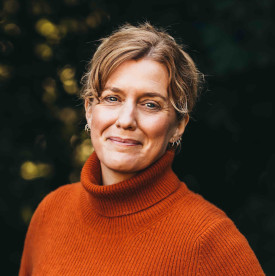
Michelle Nijhuis is an award-winning writer with a background in biology who focuses on stories about conservation and global change. (Photo by Darcy Hunter)
NIJHUIS: There is a long history of racism and colonialism in the conservation movement, which is not to say that the project of conservation that the work of conservation is necessarily racist or colonialist or to say that conservationists as a whole, have these blind spots. But it is to say that in every generation of the conservation movement, there have been people who have these very destructive, blind spots. One of the reasons I wanted to write this book is that I felt that it can only be good for conservation, for conservationists, to examine this history, to look at these patterns and see how they can be avoided in the future. I think the conservation movement, in many ways has learned from its mistakes. And there is a reckoning now over race and privilege taking place in society that I think the conservation movement is involved in in a very significant way. And I think many people are learning from that. And I think that's a very promising sign for the future. In the past, these blind spots have been so counterproductive for conservation because they have left out most of society, they have shut most of society out of the conservation movement. A more inclusive conservation movement will not only be a more just place to be an activist, but it will also be more effective, in that includes people in a constructive role in conservation.
DOERING: Michelle, Nijhuis is the author of Beloved Beasts Fighting for Life in an Age of Extinction. Thank you so much, Michelle.
NIJHUIS: Thank you, Jenni.
Links
Learn more about Michelle Nijhuis and her work
Learn more about the Hawk Mountain Sanctuary founded by Rosalie Edge
Living on Earth wants to hear from you!
Living on Earth
62 Calef Highway, Suite 212
Lee, NH 03861
Telephone: 617-287-4121
E-mail: comments@loe.org
Newsletter [Click here]
Donate to Living on Earth!
Living on Earth is an independent media program and relies entirely on contributions from listeners and institutions supporting public service. Please donate now to preserve an independent environmental voice.
NewsletterLiving on Earth offers a weekly delivery of the show's rundown to your mailbox. Sign up for our newsletter today!
 Sailors For The Sea: Be the change you want to sea.
Sailors For The Sea: Be the change you want to sea.
 The Grantham Foundation for the Protection of the Environment: Committed to protecting and improving the health of the global environment.
The Grantham Foundation for the Protection of the Environment: Committed to protecting and improving the health of the global environment.
 Contribute to Living on Earth and receive, as our gift to you, an archival print of one of Mark Seth Lender's extraordinary wildlife photographs. Follow the link to see Mark's current collection of photographs.
Contribute to Living on Earth and receive, as our gift to you, an archival print of one of Mark Seth Lender's extraordinary wildlife photographs. Follow the link to see Mark's current collection of photographs.
 Buy a signed copy of Mark Seth Lender's book Smeagull the Seagull & support Living on Earth
Buy a signed copy of Mark Seth Lender's book Smeagull the Seagull & support Living on Earth

